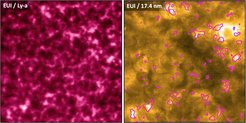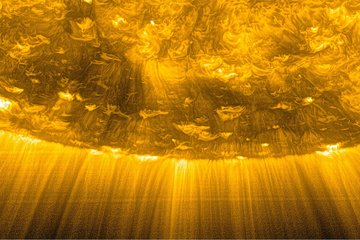Studying the upper solar atmosphere with Solar Orbiter
(Solar-C)
Imaging and spectroscopy in the extreme UV with Solar Orbiter
Solar Orbiter is a mission of ESA and NASA to explore the Sun-Heliosphere and Sun-Earth connections that was launched in February 2020. It is now on its way to reach an elliptical orbit around our central star bringing it as close as 0.3 AU to the Sun. Never before have instruments observed the atmospheric layers from the photosphere to the corona from such close distance.
Solar Orbiter data will provide a new and unique a combination of imaging and spectroscopy in the extreme UV together with magnetic field measurements at the surface that will lead to a new understanding of the processes that drive and heat the corona of the Sun. Through the investigation of the response of the upper solar atmosphere to waves, braiding of field lines, and reconnection processes we will gain insight into how structures in the upper atmosphere form and evolve. Through this, our basic research will lay groundwork to predict space weather, a fast-growing discipline that still lacks a physics-based foundation. Also, the X-ray emission from the upper atmosphere of a cool star like the Sun is one of the ingredients that define the habitable zone around newly forming planetary systems.
Here at MPS we are deeply involved in four of the main remote-sensing instruments on-board Solar Orbiter, namely the Polarimetric and Helioseismic Imager (PHI) to measure the surface magnetic field, the Extreme Ultraviolet Imager (EUI) to image the chromosphere and corona, the Spectral Imaging of the Coronal Environment (SPICE) to perform extreme UV spectroscopy and the coronagraph Metis to investigate the large-scale corona. We expect the first full science-grade data in early 2022, which would be ideal timing for students starting in the fall of 2021. With its strong role in the data calibration and intimate knowledge of the above instruments, MPS is a one of the best places to use remote-sensing data of Solar Orbiter to decipher the riddles still hidden in the Sun’s upper atmosphere.
Here is a selection of possible themes for PhD projects in this framework.
- Observing the solar wind source from active regions, coronal holes, and the quiet Sun.
- Observations of thermal structure and turbulence in the upper solar atmosphere.
- Small-scale surface magnetic field governing the dynamics of coronal structures.
More information on the Solar and stellar coronae group and the group's work can be found at the Solar and stellar coronae group homepage. For questions please contact Luca Teriaca or Hardi Peter.












